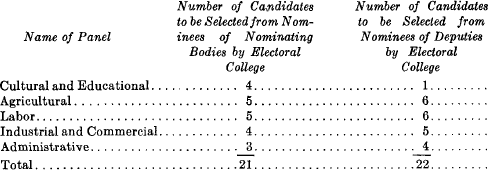No CrossRef data available.
Published online by Cambridge University Press: 02 September 2013
Out of an Irish dilemma has come one of the most striking legislative experiments in modern government. After a short life from 1922 to 1936, the first Irish upper house proved so inept as to be abolished. Then came an interval of unicameralism, and now under the constitution of 1937 another senate has been brought into existence, differing radically from the old. In the early days of her independence, Ireland was confronted with the problem of precisely how to constitute an upper house, how to differentiate it from the lower house, and whom to represent in it. Now, after a vicissitudinous history, she has embarked upon a course of advanced ideas in parliamentary practice—upon a plan which attempts to secure vocational representation.
Why has it been difficult to fit a second chamber into the structure of the Irish state? In feudal society, class cleavage produced assemblies of more than one house. Since democratization of the social order, this basis of separation, has lost significance, but the tradition persists in the bicameralism of such countries as England.
2 Bunreacht na hEireann (Constitution of Ireland), Art. 40, sec. 2, par. 1.
3 Macardle, Dorothy, The Irish Republic (1937), pp. 614–615.Google Scholar
4 Constitution of the Irish Free State (1922), Art. 45.
5 The Chamber of Commerce, the Royal College of Physicians, the Royal College of Surgeons, the Benchers of the Honourable Society of King's Inn, Dublin, the Incorporated Law Society of Ireland, and the county borough councils. See resolution of Dáil Eireann, Oct. 25, 1922, in Mansergh, Nicholas, Government of the Irish Free State (1934), p. 76.Google Scholar
6 Constitution of the Irish Free State (1922), Art. 30.
7 These figures are from Eireann, Seanad, Parliamentary Debates, 30th May, 1934, pp. 1241–1242.Google Scholar
8 Ibid., 21st March, 1934, p. 874.
9 Irish Review and Annual, 1936 (Supplement to The Irish Times.), Jan. 1, 1937.
10 Eireann, Saorstát, Report of the Second House of the Oireachtas Commission (1936), pp. 26–34.Google Scholar
11 Eireann, Dáil, Parliamentary Debates, 11th May, 1937, p. 56.Google Scholar
12 The representation originally accorded to the universities in the Dáil was omitted by the new constitution.
13 This panel includes law and medicine (surgery, dentistry, veterinary medicine, and pharmaceutical chemistry), according to the Seanad Electoral (Panel Members) Act, 1937.
14 Bunreacht na hEireann, 1937, Art. 19.
15 Seanad Electoral (Panel Members) Act; No. 43 of 1937.
16 Each of these 31 councils was authorized to select seven electors by proportional representation, making a total of 217 such electors.
17 Seanad Electoral (Panel Members) Act, 1937.

18 Mr. Wilfrid Brown, of the Department of Local Government and Public Health, has served in this capacity.
19 The Irish Press, Feb. 25, 1938.
20 Eireann, Dáil, Parliamentary Debates, 11th May, 1937, p. 56.Google Scholar
21 Iris Oifigiúil, March 15, 1938, pp. 401–402.
22 See The Irish Press, March 30, 1938.
23 Irish Review and Annual, 1938 (supplement to The Irish Times), Jan. 1, 1939.
24 In this election, there were 353 members of the electoral college and 129 candidates on the panels. Iris Oifigiúil, July 29, 1938, pp. 999–1006.
25 Commission on Vocational Organization, Terms of Reference.
26 Bunreacht na hEireann, 1937, Art. 15, sec. 3, par. 1 and 2.
27 Dail Eireann, Parliamentary Debates, 11th May, 1937, p. 58.
28 The Weekly Irish Times, Nov. 12, 1938.
29 Bunreacht na hEireann, 1937, Art. 18, sec. 7, par. 1.
30 See Webb, J. J., The Guilds of Dublin (1929), pp. 56–57.Google Scholar
31 Bunreacht na hEireann, 1937, Art. 27, sec. 1.
32 Ibid., Art. 24, sec. 3.
33 Eireann, Dáil, Parliamentary Debates, 11th May, 1937, p. 60.Google Scholar
34 Bunreacht na hEireann, 1937, Art. 28, sec. 8.
35 Standing Orders of Seanad Eireann Relative to Public Business, 1938, Sec. 36.
36 Eireann, Seanad, Parliamentary Debates, 1938, Vol. 21.Google Scholar
37 Eireann, Seanad, Parliamentary Debates, 26th July, 1939, pp. 955–1010.Google Scholar
38 Ibid., 1938–1939, Vol. 22.
39 The constitution does not, of course, provide for an exclusively functional assembly, since 11 of the 60 members are chosen by the executive and six by the universities. Moreover, vocational associations control only the nominations, not the elections, which are in the hands of political groups.
40 Bunreacht na hEireann, 1937, Art. 18, sec. 7.
41 The Irish Press, June 8, 1938.
42 Leo, Pope XIII, Rerum Novarum (Paulist Press, 1891).Google Scholar
43 See N. Y. Times, May 24, 1931, for Quadragesimo Anno.
44 Appreciation is expressed for the numerous courtesies of Professor Felix E. Hackett, Senator Helena Concannon, Senator Desmond Fitzgerald, Senator Michael Tierney, Mr. Seán Malone, clerk of the Senate, and Mr. Wilfrid Brown, Senate returning officer.
Comments
No Comments have been published for this article.